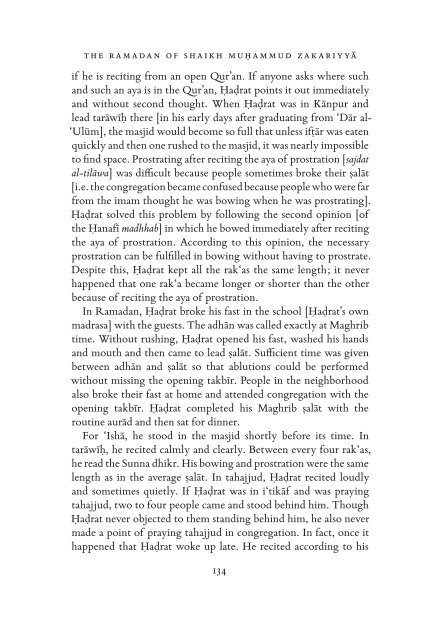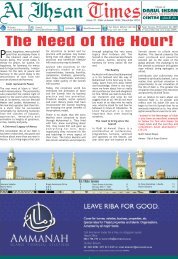TheRamadan of Shaykh Al-Hadith Ml ZakariyyaKandelwi by Dr Muhammad Ismail Memon Madani
TheRamadan of Shaykh Al-Hadith Ml ZakariyyaKandelwi by Dr Muhammad Ismail Memon Madani
TheRamadan of Shaykh Al-Hadith Ml ZakariyyaKandelwi by Dr Muhammad Ismail Memon Madani
You also want an ePaper? Increase the reach of your titles
YUMPU automatically turns print PDFs into web optimized ePapers that Google loves.
the ramadan <strong>of</strong> shaikh muĤ ammud zakariyyĀ<br />
if he is reciting from an open Qur’an. If anyone asks where such<br />
and such an aya is in the Qur’an, Ĥađrat points it out immediately<br />
and without second thought. When Ĥađrat was in Kānpur and<br />
lead tarāwīĥ there [in his early days after graduating from ‘Dār al-<br />
‘Ulūm], the masjid would become so full that unless ifţār was eaten<br />
quickly and then one rushed to the masjid, it was nearly impossible<br />
to find space. Prostrating after reciting the aya <strong>of</strong> prostration [sajdat<br />
al-tilāwa] was difficult because people sometimes broke their śalāt<br />
[i.e. the congregation became confused because people who were far<br />
from the imam thought he was bowing when he was prostrating].<br />
Ĥađrat solved this problem <strong>by</strong> following the second opinion [<strong>of</strong><br />
the Ĥanafī madhhab] in which he bowed immediately after reciting<br />
the aya <strong>of</strong> prostration. According to this opinion, the necessary<br />
prostration can be fulfilled in bowing without having to prostrate.<br />
Despite this, Ĥađrat kept all the rak‘as the same length; it never<br />
happened that one rak‘a became longer or shorter than the other<br />
because <strong>of</strong> reciting the aya <strong>of</strong> prostration.<br />
In Ramadan, Ĥađrat broke his fast in the school [Ĥađrat’s own<br />
madrasa] with the guests. The adhān was called exactly at Maghrib<br />
time. Without rushing, Ĥađrat opened his fast, washed his hands<br />
and mouth and then came to lead śalāt. Sufficient time was given<br />
between adhān and śalāt so that ablutions could be performed<br />
without missing the opening takbīr. People in the neighborhood<br />
also broke their fast at home and attended congregation with the<br />
opening takbīr. Ĥađrat completed his Maghrib śalāt with the<br />
routine aurād and then sat for dinner.<br />
For ‘Ishā, he stood in the masjid shortly before its time. In<br />
tarāwīĥ, he recited calmly and clearly. Between every four rak‘as,<br />
he read the Sunna dhikr. His bowing and prostration were the same<br />
length as in the average śalāt. In tahajjud, Ĥađrat recited loudly<br />
and sometimes quietly. If Ĥađrat was in i‘tikāf and was praying<br />
tahajjud, two to four people came and stood behind him. Though<br />
Ĥađrat never objected to them standing behind him, he also never<br />
made a point <strong>of</strong> praying tahajjud in congregation. In fact, once it<br />
happened that Ĥađrat woke up late. He recited according to his<br />
134



